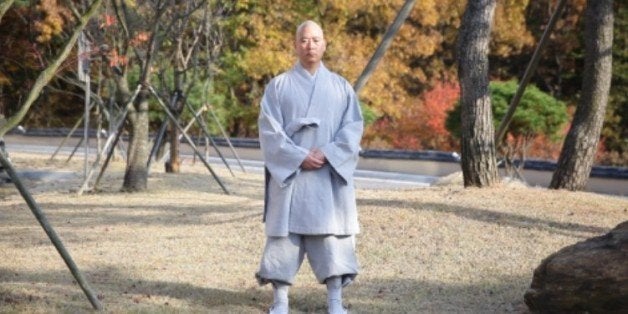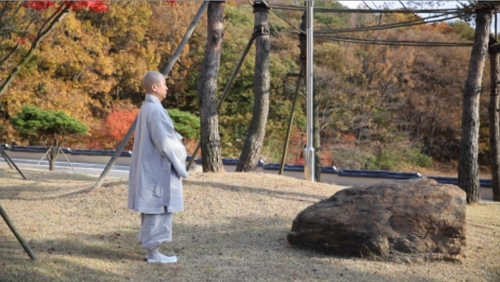
There are two modes of Son Buddhist meditation: "Son in the midst of stillness" and "Son in the midst of commotion." I like to refer to them as simply the "quiet" and "active" modes of meditation. Quiet meditation commonly refers to traditional seated meditation but includes any meditative form where you're not moving. Active meditation refers to meditating while in motion in the midst of daily life.
Active meditation is considered more advanced and confers the advantage of not having to set aside a special time and place to meditate. Another great benefit is that once you have mastered being able to meditate wherever you are, you can begin to use meditation as a therapeutic coping mechanism to recover from unexpected surprises right on the spot and as a method of improving your way of communicating and behaving. In a word, active meditation is both healing and empowering.
Practically speaking, however, in order to get to this level we first have to learn how to meditate in a variety of physical postures. So today I'll share with you the method of meditating in a standing position.
Correct Standing Posture: Practice with bare feet first.
(Please read and practice the instructions in my earlier blog posts, "How to Meditate Sitting in a Chair, Part 1 and Part 2," before attempting the meditation described below.)
1. Stand straight with your feet shoulder width apart and parallel to one another.
2. Pay close attention to the bottoms of your feet. You should feel that with the exception of your arches every part of the bottoms of your feet is making good sticky contact with the floor. Imagine that the bottom of each foot is a rectangle divided into four quadrants: northwest, northeast, southeast, and southwest. Make sure that your weight is evenly distributed across the four quadrants -- again, allowing only your arches to stay up. You're not standing on the sides of your feet or on the inner edges. You're also not tipping forward onto the balls of your feet or backing away onto your heels. Your weight is evenly spread across the bottoms of your feet to create that physical and mental sensation that people call "centered."
3. Lift up and spread your toes as much as you can. Then, set them down again and feel the contact that your toe pads make with the floor. Imagine that the bottoms of your feet are stretched to their maximum width and length to create the largest possible planes of contact with the earth.
4. You are now more than centered. You are grounded.
5. Straighten your spine to its maximum length. Many people, when they try to do this, tend to flex their chest forward, which creates an unnatural arch in their upper spine. Instead, focus on the imaginary lines on the left and right sides of your rib cage that extend from the upper tip of your hip bone to the armpit. Imagine that these lines are getting longer. Imagine that someone has glued your feet to the floor and two hooks beneath your armpits are lifting and stretching your upper torso to the ceiling. Stand tall like a tree and feel your mind shift into a more expansive, peaceful and confident mindset.
6. Bending your knees slightly, tuck in your butt gently so that your tailbone seems to curl under you. Imagine that your pelvis is a large bowl filled to the brim with water. If you tend to stick your butt out backward, the front rim of your pelvic bowl will tip forward and spill water. On the other hand, if you tend to push your belly forward, the back rim of the bowl will spill over. Keep your pelvis as level as possible.
7. Now tuck your chin in slightly so that the crown of your head rises even higher.
8. Look forward with comfortably open eyes and gently place the tip of your tongue against the roof of your mouth.
9. Hold your left hand in your right hand as shown in the photo and place both hands on your abdomen. When you engage diaphragmatic breathing, your hands will feel your belly moving and you'll be able to concentrate on your breath much more effectively.
MEDITATION TIP: Your nose should be directly above your navel and your ears above your shoulders. If you're sensitive enough, try to align the crown of your head directly above your perineum. If you do it very precisely, you'll feel that your back and neck click into place. Then, your spine will seem to rise up toward the sky effortlessly and as your mood brightens and your mind becomes more lucid, you will feel the tingling electric flow of energy in your body that the ancient Chinese called qi.
Preparation Breathing: Detoxifies and cleanses your mind and body
1. Inhale through your nose and completely fill your chest. Hold your breath until it feels mildly uncomfortable. Then, exhale completely through your mouth
2. Repeat three times. Then, engage diaphragmatic breathing.
Diaphragmatic Breathing: The primary breathing method of Son meditation
1. Inhale softly and slowly through your nose as you push out your belly as if it's filling up with air. Inhalation time should be about 2-3 seconds.
2. Pause when your belly feels 80 percent full for about 2-3 seconds.
3. Exhale even more slowly through your nose as you draw your belly in toward your spine as if you're squeezing the air out. Exhalation time should be about 3-4 seconds.
Thought Regulation: "Yi-mwot-go?" and the Great Doubt
1. Continue to perform diaphragmatic breathing, but when you exhale, in your mind intone, "Yi-mwot-go?" and generate the Great Doubt.
2. "Yi-mwot-go?" means "This. What is this?" What is this that directs my body when I move? What is this that generates the thoughts that I think? What is this that feels the emotions that rise up in me? When someone calls my name, what is it within me that recognizes the sound of my own name and looks to see who called? What is this that is asking, "What is this?"
3. By repeatedly asking ourselves this question in coordination with our breathing, we create, maintain, and increase the state of Doubt. Mentally, this is a condition of urgent questioning, the state of attempting to know the unknowable and see the invisible. Emotionally and physically, it is a sensation of feeling stuck -- the way you feel when you can't remember where you put a set of missing keys. Ultimately, we are attempting to direct our attention back at its own source.
4. Then, the Great Doubt acts as a cleansing flame in our bodies and minds, purging us of tension, worry, hostility, fear and sorrow. We feel consoled and unburdened, luminous and at peace with ourselves, and in the end, free.
As you practice standing meditation, you develop a greater kinesthetic awareness of your body -- a clear sense of your orientation in space and among people. You take a step away from the habit of always passively staring at whatever's going on in your head and you begin to notice the sensations of living more. Colors, sounds, textures, and odors assume greater depth and immediacy. Physical stimuli and emotions feel somehow fresher, more real -- even as you notice how fleeting and evanescent the so-called "real world" is. And this is just the beginning. Each person takes her own path through meditation and gains her own unique insights which nonetheless can be shared with the world and added to our treasury of knowledge.
Mastering the standing posture is the first step in being able to incorporate meditation into our daily lives. Like everything worthwhile in life, it requires practice, but once we get used to it, we can do it almost anywhere -- standing on line, at the crosswalk, and in elevators. When you're about to give a speech, before you go on stage or out in front of people, stand in meditation for a few breaths and clear your mind of everything but your powerful intention to get this done right. When you're about to meet someone, meditate and clear your mind so you can give them your complete calm and undivided attention. When you meditate before you engage in something, you'll be surprised at how confident, expansive, and generous you feel.
And when something catches us off-guard, we can stand in meditation for a few moments -- or even for the space of one breath -- and let the Great Doubt of "Yi-mwot-go?" restore us. We refrain from a knee-jerk reaction. Instead, we coolly, quickly evaluate the situation and come to a decision about what to do next.
As meditators, we now have the ability to come literally to a standstill when we need to. Standing meditation endows us with the capacity to inject moments of clarity and sanity, common sense and love into the never-ending blur of activity that modern life can so often be. We wake up from that weird dream of doing one thing while thinking another that so many of us mistake for living. And what we experience, at the very least, when we wake up, is the beauty and gratitude of living in this strange and wondrous universe.
In order to gain these benefits, it's important for beginners to practice seated meditation everyday. Remember that meditation requires a discrete set of skills in achieving relaxed posture, natural diaphragmatic breathing, and sustained direction of attention. It takes practice to master these skills. So make a daily habit of meditating at home. Then, it will become easy to enter a meditative state instantly from a standing position in daily life. I hope you come back next time as we continue to learn how to meditate in daily life. Take care!
Palms together,
Hwansan Sunim
To see a demonstration of both seated meditation in a chair and standing meditation, view "A Meditation to Address Workplace Unhappiness" in The Huffington Post by searching my name. This is Episode #6 of our TV program "Son Meditation in English with Hwansan Sunim" also available on Youtube. For more information, visit https://www.facebook.com/seonbuddhism.

